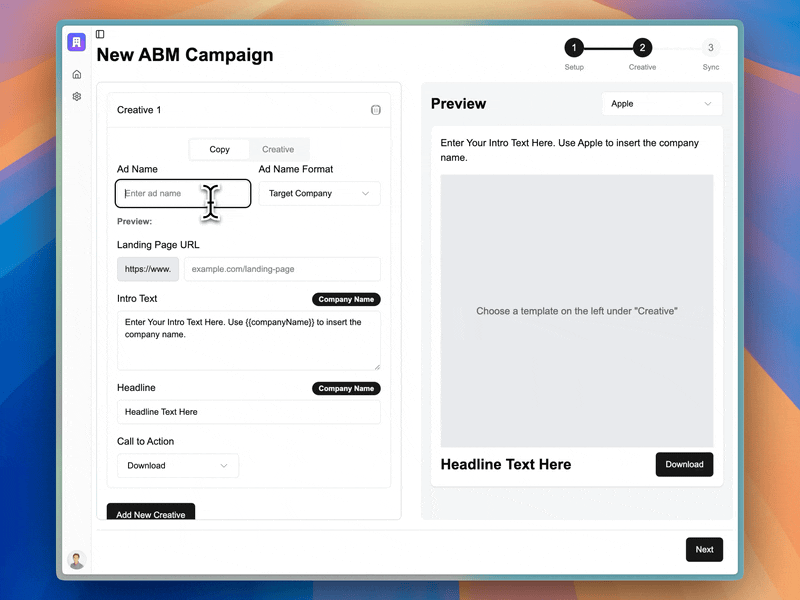To have a successful ABM advertising campaign, you must create ads that speak directly to your most valuable leads. As a result, generic creatives won’t give you the results you need. Custom creative assets are integral to balancing attractive visuals and compelling messages that resonate with your audience.
But designing custom creative assets requires a personalized approach. How can brands develop these creatives? Here are our recommendations.
Key Highlights
- Custom creative assets for LinkedIn ABM campaigns can improve engagement rates by up to 72% compared to generic approaches
- 97% of marketers report that ABM delivers a higher return on investment than other marketing strategies
- Visual personalization increases conversion rates by 35% compared to text-only personalization
- Modular design systems enable scalable personalization across hundreds of target accounts
- Brand consistency balanced with personalization is essential for recognition and trust
- AI-powered tools like Karrot.ai can automate the creation of personalized creative at scale
- Systematic testing of creative elements identifies optimal approaches for different segments
- Cross-functional collaboration between marketing, design, and sales improves creative relevance
TABLE OF CONTENTS:
The Dilemma Behind Creatives in LinkedIn ABM
93% of businesses say their ABM campaign has been successful or extremely successful, with LinkedIn being at the forefront of advertising and outreach.
However, the effectiveness of LinkedIn ABM campaigns is determined by creative quality and relevance. While personalized ads can increase click-through rates by 50%, LinkedIn is a competitive platform. Creative assets can be the dividing line between a captivating ad and a generic one.
Challenges With Ad Personalization

62% of leaders say personalization has increased customer retention. However, marketers face a fundamental challenge when designing creative content for LinkedIn ABM. Here are reasons why:
- Personalization imperative: Need for account-specific relevance.
- Scale requirements: Targeting dozens or hundreds of accounts.
- Resource constraints: Limited design and production capacity.
- Brand consistency: Maintaining coherent visual identity.
- Platform limitations: Working within LinkedIn’s format restrictions.
This personalization paradox—the need to be both customized and scalable—requires a systematic approach to creative development rather than ad hoc design.
The Creative Asset Framework for LinkedIn ABM
Effective LinkedIn ABM creative requires a structured framework that balances personalization with scalability. How do you build a framework while maintaining your ROI?
Asset Hierarchy
Implement a hierarchical approach to creative development, such as this:
Creative Hierarchy:
– Master Brand Templates
– Industry-Specific Variations
– Role-Based Adaptations
– Account-Specific Personalizations
– Testing Variations
This structured approach ensures creative assets maintain brand consistency while enabling multiple levels of customization.
Modular Design System
Develop a modular system with interchangeable components. Here’s an example of one:
- Header modules: Different headline and visual combinations.
- Value proposition modules: Various messaging frameworks.
- Social proof modules: Different testimonial and case study formats.
- Solution modules: Various feature/benefit presentations.
- Call-to-action modules: Different actions and approaches.
This modular approach allows significant personalization while maintaining design consistency and production efficiency.
Personalization Zones
Identify specific areas within templates for dynamic personalization. Here are examples of ways you can personalize content:
[HEADER ZONE]
- Company name insertion
- Industry-specific headline variation
- Account-specific hero image
[MESSAGING ZONE]
- Industry-specific pain points
- Role-based value propositions
- Account-specific challenge framing
[PROOF ZONE]
- Industry-relevant case studies
- Competitive displacement messaging
- Similar account testimonials
[CONVERSION ZONE]
- Account-specific offer
- Personalized next steps
- Custom call-to-action
These designated zones create a framework for personalization that can be implemented at scale.
Step 1: Establish Your Creative Strategy
Before designing assets, establish a clear creative strategy aligned with your LinkedIn ABM objectives. Your creative strategy should also be tailored to your audience and include the visual elements to boost your messaging.
Creative Brief Development
Create comprehensive creative briefs that include:
- Campaign objectives: Specific goals and KPIs.
- Target audience insights: Detailed persona information.
- Value proposition: Core messaging for different segments.
- Competitive context: How competitors are positioning themselves.
- Brand guidelines: Visual and messaging parameters.
- Technical requirements: Format specifications and limitations.
- Personalization approach: Which elements will be customized?
This detailed briefing ensures creative development is strategically aligned rather than purely aesthetic.
Personalization Matrix
Develop a matrix that maps personalization elements to account attributes, such as this one:
| Account Attribute | Visual Approach | Headline Strategy | Value Proposition | Call-to-Action |
|---|---|---|---|---|
| Industry: Financial | Security-focused imagery | Compliance-centered headlines | Risk reduction messaging | “Strengthen compliance” |
| Industry: Healthcare | Patient-centered visuals | Outcome-focused headlines | Care improvement messaging | “Enhance patient care” |
| Size: Enterprise | Enterprise-scale imagery | Complexity-focused headlines | Integration messaging | “Streamline operations” |
| Size: Mid-market | Growth-oriented visuals | Efficiency-centered headlines | Competitive advantage messaging | “Accelerate growth” |
This matrix ensures personalization is systematically applied based on account characteristics rather than randomly assigned. Adhering to a matrix saves resources and time, since you’re highlighting the creatives and messaging for each audience segment.
Creative Testing Plan
Data-driven insights will highlight what’s working and what isn’t. Develop a structured plan for creative testing and refine your strategy when needed. Here are examples of testing creatives:
- Identify test variables: Which elements will be tested?
- Establish test methodology: How variations will be compared.
- Define success metrics: What determines a winning variation?
- Create test schedule: When tests will be conducted.
- Document learning process: How insights will be captured and applied.
This testing plan ensures creative optimization is systematic rather than intuitive.
Step 2: Design for LinkedIn
LinkedIn has unique characteristics that influence creative effectiveness. For example, your creatives will perform better if you design with the LinkedIn app in mind. Here are a few additional examples.
Format Optimization
Design your display ads specifically for LinkedIn’s advertising formats. Here are LinkedIn’s ad requirements:
- Single Image Ads: 1200 x 627 pixels, minimal text.
- Carousel Ads: 1080 x 1080 pixels, 2-10 cards.
- Video Ads: 16:9 ratio, under 30 seconds optimal.
- Message Ads: Text-based with optional banner.
- Conversation Ads: Interactive messaging format.
Visual Hierarchy for Feed Environment
Design for LinkedIn’s busy feed environment by following these steps:
- Strong visual stopping power: Bold imagery that interrupts scrolling.
- Clear brand identification: Immediate recognition within 0.3 seconds.
- Concise headline: Readable at a glance (5-7 words optimal).
- Scannable body copy: Short paragraphs with key points highlighted.
- Distinct call-to-action: Visually prominent conversion element.
This feed-optimized approach ensures creative assets capture attention in LinkedIn’s competitive environment.
Mobile-First Design
Prioritize mobile experience in creative development by designing ads for smaller screens. Here are a few recommendations:
- Simplified layouts: Clean designs that work at small sizes.
- Larger text: Minimum 16pt font for readability.
- High contrast: Clear distinction between elements.
- Touch-friendly: Easily clickable buttons and interactive elements.
- Quick loading: Optimized file sizes for mobile connections.
With over 57% of LinkedIn users accessing the platform via mobile devices, app optimization is essential for campaign performance.
Step 3: Implement Visual Personalization
Visual elements are potent drivers of personalization. Here are ways to personalize your ad creatives.
Account-Specific Imagery
Develop approaches for visual personalization, such as:
- Industry-specific imagery: Visuals relevant to the account’s sector.
- Role-based visuals: Different imagery for various stakeholders.
- Challenge-specific graphics: Visuals that illustrate specific pain points.
- Outcome visualization: Imagery showing desired results.
- Brand-aligned colors: Color schemes that complement account branding.
Don’t forget that brands that use personalization drive 40% more revenue.
Data Visualization
Transform account-specific data into compelling visuals, such as:
- Benchmark comparisons: How the account compares to industry standards.
- Opportunity quantification: Visual representation of potential value.
- Process visualization: How solutions address specific workflows.
- Outcome projections: Expected results based on similar accounts.
- ROI calculations: Visual breakdown of potential return.
These data visualizations transform abstract concepts into tangible value, significantly increasing engagement with analytical decision-makers.
The Karrot.ai Advantage

Platforms like Karrot.ai transform visual personalization through:
- Automated image selection from vast libraries based on account attributes
- Dynamic text overlay with account-specific information
- Color scheme adaptation that maintains brand guidelines while personalizing
- Layout optimization based on content requirements
- Visual element testing to identify highest-performing options
This AI-powered approach enables visual personalization at scale without overwhelming design resources.
Step 4: Craft Compelling Personalized Copy
Personalization in messaging is essential for LinkedIn ABM to ensure your copy will resonate with readers. At the same time, you’ll need to do more than discuss the benefits or features of your products and services. Your copy must be personalized to your accounts, explaining how it will solve their pain points. Here are some ways to do this.
Headline Personalization
Create headline frameworks that enable personalization based on user data. This data can include behaviors, interests, or any actions you want your accounts to take. Here are a few examples of personalized headlines:
- Industry-specific challenges: “[Industry] Leaders Are Solving [Challenge].”
- Outcome-focused statements: “How [Similar Company] Achieved [Result].”
- Question formats: “Is [Specific Challenge] Holding [Company Name] Back?”
- Statistic-led headlines: “[Specific Statistic] of [Industry] Companies Are…”
- Disruption statements: “The End of [Industry Challenge] for [Company Name].”
Value Proposition Customization
Develop approaches for customizing value propositions, such as:
- Industry-specific value: How solutions address sector-specific challenges.
- Role-based benefits: Different advantages for various stakeholders.
- Size-appropriate messaging: Value scaled to organization size.
- Challenge-specific solutions: How offerings solve particular problems.
- Competitive displacement: Value compared to current approaches.
This multi-dimensional customization ensures messaging resonates with the specific context of each account.
Call-to-Action Personalization
Personalized CTAs perform 202% better than generic ones. Optimize CTAs for different accounts and stages:
| Account Stage | CTA Approach | Example |
|---|---|---|
| Awareness | Educational CTAs | “Discover how [industry] leaders are…” |
| Consideration | Solution-focused CTAs | “See how [solution] solves [challenge]” |
| Decision | Action-oriented CTAs | “Schedule your [company name] consultation” |
| Existing Customer | Expansion CTAs | “Enhance your current [solution] with…” |
This stage-appropriate approach ensures CTAs match the account’s readiness, improving conversion rates.
Step 5: Develop a Scalable Production System
Designing creatives requires a massive workload. And when personalization is involved, you’ll handle a lot of data. Scaling personalization is a solution, but it also requires systematic production approaches.
Template Development
Create flexible templates that enable efficient personalization:
- Master templates: Core designs with personalization zones and custom fields.
- Component library: Reusable elements for different variations.
- Text frameworks: Structured copy with variable elements.
- Asset management system: An organized repository of creative elements.
- Production guidelines: Clear rules for template implementation.
Automation Implementation
AI can accelerate the creation of content and creatives. Leverage automation to scale personalization by:
- Data integration: Connect account data to creative systems.
- Rules-based personalization: Define how account attributes influence creative.
- Dynamic content generation: Automatically create variations based on rules.
- Quality assurance automation: Systematically review generated assets.
- Distribution automation: Streamline delivery to LinkedIn campaigns.
This automated approach enables personalization across hundreds or thousands of accounts without proportional resource requirements.
The Karrot.ai Production Advantage
Platforms like Karrot.ai transform creative production through:
- Template-based generation that maintains brand consistency
- Mass customization across entire account lists
- Dynamic creative optimization based on performance data
- Continuous refreshment to prevent creative fatigue
- Quality control automation to ensure error-free output
Step 6: Implement Systematic Creative Testing
Continuous testing is essential for creative optimization. Here are the most effective ad creative testing strategies.
Element-Level Testing
Test specific creative elements rather than complete ads:
- Headline testing: Compare different messaging approaches.
- Visual testing: Evaluate different imagery and design elements.
- Copy testing: Compare different messages.
- CTA testing: Test different conversion approaches.
- Layout testing: Compare different structural approaches.
This granular testing identifies which specific elements drive performance rather than treating ads as indivisible units.
Segment-Specific Optimization
Analyze performance by account segment, such as:
- Industry-specific patterns: Which approaches work for different sectors?
- Role-based preferences: What resonates with different stakeholders?
- Company size variations: How preferences change by organization scale.
- Engagement stage differences: What works at different funnel stages?
- Previous interaction patterns: How past engagement influences response.
This segmented analysis reveals optimization opportunities that aren’t apparent in aggregate data.
Continuous Improvement Cycle
Implement an ongoing optimization process, such as:
- Performance monitoring: Regular review of creative metrics.
- Pattern identification: Recognition of performance trends.
- Hypothesis development: Theories about improvement opportunities.
- Test implementation: Controlled experiments to validate hypotheses.
- Learning documentation: Systematic recording of insights.
- Template refinement: Updating master templates based on learnings.
This continuous cycle ensures creative assets stay innovative while boosting efficiency.
Step 7: Ensure Brand Consistency
Balancing personalization with brand consistency is essential to producing valuable ads. Here are ways to communicate your brand perception through ABM ads.
Brand Guidelines for Personalization
Develop clear parameters for branding in your personalization. These elements should stay consistent but be flexible enough to target accounts. Here are brand elements that should never change versus variables that should be flexible.
Brand constants (never change):
- Logo usage and placement
- Primary brand colors
- Typography system
- Voice and tone principles
- Key messaging pillars
Personalization variables (can be customized):
- Secondary imagery
- Supporting copy
- Data visualization
- Case study selection
- Call-to-action framing
These variables ensure personalization enhances rather than dilutes brand identity.
Quality Assurance Process
Implement systematic quality control with this checklist:
- Automated checks: System validation of brand compliance.
- Visual review: Design team assessment of visual execution.
- Messaging review: Marketing validation of copy elements.
- Stakeholder approval: Appropriate sign-off for key accounts.
- Pre-launch verification: Final check before campaign activation.
This multi-layered approach ensures personalized assets maintain quality standards across all variations.
Brand Evolution Framework
Establish a process for brand evolution within ABM while prioritizing messaging and creatives that drive impact. Follow this framework for best results:
- Performance-based refinement: Adjusting guidelines based on results.
- Competitive differentiation: Evolving visual approach to maintain distinction.
- Trend adaptation: Incorporating relevant design trends.
- Platform optimization: Adjusting to LinkedIn’s evolving environment.
- Audience response: Refining based on target account feedback.
This evolution framework ensures brand expression remains relevant while maintaining core identity.
Case Study: Tech Company Transforms Results with Custom Creative
A B2B software company implemented a comprehensive creative strategy for their LinkedIn ABM campaign targeting 500 enterprise accounts. By developing custom creative assets, they:
- Created a modular design system with industry-specific variations.
- Implemented account-specific personalization for their top 100 accounts.
- Developed role-based messaging for five key stakeholder groups.
- Implemented systematic testing of creative elements.
- Used Karrot.ai to scale personalization across their entire account list.
The results demonstrated the power of custom creative:
- 187% increase in click-through rates compared to previous generic campaigns.
- 64% improvement in landing page conversion rates.
- 42% reduction in cost-per-lead.
- 3.2X increase in engagement from target accounts.
- 78% of the sales team reported higher quality conversations.
Best Practices for LinkedIn ABM Creative Success
To maximize the effectiveness of your custom creative assets, follow these proven best practices:
- Start with strategy rather than jumping directly to design
- Develop a modular system that enables efficient personalization
- Balance brand consistency with personalization through clear guidelines
- Design specifically for LinkedIn’s environment rather than repurposing assets
- Implement systematic testing to identify what works for different segments
- Leverage automation tools like Karrot.ai to enable scale without sacrificing quality
- Create a continuous improvement process rather than a one-time creative development
- Involve sales in the creative process to ensure relevance to customer conversations
- Document learnings to build organizational creative capabilities
- Refresh creative regularly to prevent fatigue and maintain performance
Designing Custom Creative Assets Is Possible With the Right Strategy
Creating valuable ads is only one step to ABM advertising. Custom creative assets are what will drive engagements among your accounts.
Designing custom creative assets for LinkedIn ABM campaigns represents one of the most significant opportunities for improving campaign performance. Personalized ads can further attract and retain accounts while driving revenue.
But designing custom creative assets can take a toll on your time and resources. Many brands use tools like Karrot.ai to help scale creative personalization without sacrificing quality or increasing workload. The key is developing a scalable approach to personalization that balances impact with efficiency.




